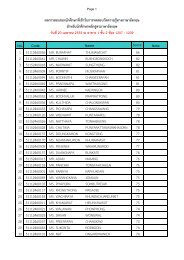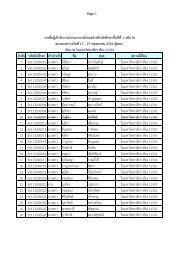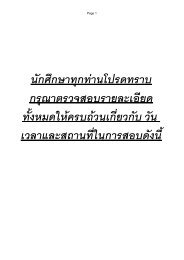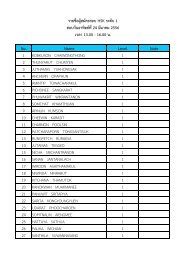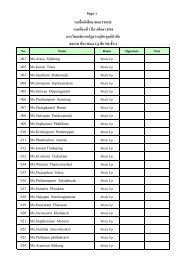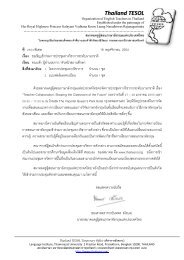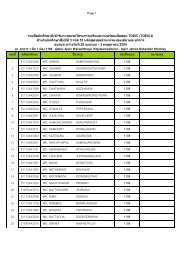Cultural Diversity & Multilingualism: Focus on ASEAN
Cultural Diversity & Multilingualism: Focus on ASEAN
Cultural Diversity & Multilingualism: Focus on ASEAN
Create successful ePaper yourself
Turn your PDF publications into a flip-book with our unique Google optimized e-Paper software.
Internati<strong>on</strong>al Days
UNESCO Atlas of Endangered Languages• 2,473 languages listed• Search by country, area, language name, number ofspeakers and degree of vitality/ endangerment;SafeDefinitelyendangeredCriticallyendangeredVulnerableSeverelyendangeredExtinct.Free Interactive Onlineresearch tool foradvocacy, m<strong>on</strong>itoringand assessment ofstatus and trends oflanguages
The <strong>ASEAN</strong> regi<strong>on</strong> displays diversitybetween and within countriesEthnic and Linguistic <str<strong>on</strong>g>Diversity</str<strong>on</strong>g>• Between and within states• Thailand: 74 language groups• Ind<strong>on</strong>esia: 719 language groups• Vietnam: 107 language groups(ethnologue.com)UNESCO Atlas of Endangered LanguagesReligious <str<strong>on</strong>g>Diversity</str<strong>on</strong>g>• Diverse World Views• Animism, Buddhism, Christianity (Catholicism),C<strong>on</strong>fucianism, Hinduism, Islam, Traditi<strong>on</strong>al beliefs…
<str<strong>on</strong>g>Diversity</str<strong>on</strong>g> in <strong>ASEAN</strong>• History shapes diversity– Empires– Movement of peoples– Modern borders drawn across ethnic, linguistic, religiouslines• Geography shapes diversity– diverse landscapes and climates
Globalizati<strong>on</strong> and the power of English• Globalizati<strong>on</strong> process• Increased appeal of Englishand other internati<strong>on</strong>allanguages: lingua franca Passport to the world Facilitate participati<strong>on</strong> ininternati<strong>on</strong>al exchanges andtherefore in ec<strong>on</strong>omicdevelopment
Is it a goodenough reas<strong>on</strong> toforget aboutother languagesand cultures?
Why is it important to maintaincultural and linguistic diversity?1. Understanding diversity can c<strong>on</strong>tribute tofostering respect and tolerance2. <str<strong>on</strong>g>Cultural</str<strong>on</strong>g> and linguistic diversityencapsulates different types of knowledge3. <str<strong>on</strong>g>Diversity</str<strong>on</strong>g> fosters innovati<strong>on</strong> and creativity,c<strong>on</strong>tributing to ec<strong>on</strong>omic development4. <str<strong>on</strong>g>Diversity</str<strong>on</strong>g> c<strong>on</strong>tributes to sustainabledevelopment
Why is it important to maintaincultural and linguistic diversity?<str<strong>on</strong>g>Diversity</str<strong>on</strong>g> isenriching.Without<str<strong>on</strong>g>Diversity</str<strong>on</strong>g>, theworld would bea dull place.
Why is it important to maintain cultural andlinguistic diversity? …Understanding diversity canc<strong>on</strong>tribute to fosteringrespect and toleranceOr is it the opposite …?
Why is it important to maintain cultural and linguistic diversity? …<str<strong>on</strong>g>Diversity</str<strong>on</strong>g> can c<strong>on</strong>tribute to intercultural dialogue• Becoming aware of cultural and linguisticdifferences allows to better understand and valuethese difference• Lack of understanding and respect for culturaldiversity can often lead to c<strong>on</strong>flict
Why is it important to maintain cultural andlinguistic diversity? …<str<strong>on</strong>g>Cultural</str<strong>on</strong>g> and linguistic diversityencapsulates different types ofknowledgeand c<strong>on</strong>tributes to educati<strong>on</strong>
Why is it important to maintain cultural and linguistic diversity? …<str<strong>on</strong>g>Diversity</str<strong>on</strong>g> encapsulates knowledgeDiverse knowledge systems can complement each otherNatural Remedies for HIGH BLOOD PRESSUREInd<strong>on</strong>esia China USAJamu – traditi<strong>on</strong>alhealing drink.Ingredients mayinclude flowers of lime,h<strong>on</strong>ey, ginger, palmsugar, cinnam<strong>on</strong>A combinati<strong>on</strong> ofAcupuncture andTraditi<strong>on</strong>al HerbsMagnesium (figs,legumes, limes…)Garlic, Cod-liver OilVariati<strong>on</strong> of Jamuhealing Juice sold todayin the USA
Why is it important to maintain cultural and linguistic diversity? …Respect for linguistic diversity c<strong>on</strong>tributesto a better educati<strong>on</strong>
Research shows that mother t<strong>on</strong>gue-based bilingualor multilingual (MTB-MLE) approaches have a positiveimpact <strong>on</strong> learning and learning outcomes.• Children are capable of acquiring2 or more languages in earlychildhood• Children who learn in theirmother-t<strong>on</strong>gue for the first 6 -8years have better academicperformance and self-esteem
Benefits of Mother-T<strong>on</strong>gue BasedMultilingual Educati<strong>on</strong> (MTB-MLE)compared with m<strong>on</strong>olingual educati<strong>on</strong>• Children receive a good foundati<strong>on</strong>• Children perform better• Fewer children repeat grades/drop out• Children receive more family support• Cycles of exclusi<strong>on</strong> are broken
Tools developed by UNESCOMultilingual Educati<strong>on</strong> Advocacy Toolkits and DVDs in regi<strong>on</strong>al languages
MTB-MLE Good practiceTimor LesteNew Mother T<strong>on</strong>gue‐Based Multilingual Educati<strong>on</strong> PilotProgram (Launched January 2012)Students in their T‐shirtswhich read: “I like using mymother t<strong>on</strong>gue to learn”“In this village we think mother t<strong>on</strong>gue‐based teaching isnecessary as it facilitates and bridges our children to theofficial languages” ‐ Village Chief, Lautem
MTB-MLE Good practiceSouthern Thailand:• 83% of the populati<strong>on</strong> speak Pattani-Malay• Regi<strong>on</strong> has decades of ethnic tensi<strong>on</strong>/c<strong>on</strong>flict• Pilot projects for Bilingual Thai and Pattani-Malayeducati<strong>on</strong> fosters community empowerment andsupports c<strong>on</strong>flict reducti<strong>on</strong>.Pattani-Malay children inMTB-MLE programme scored35 % higher <strong>on</strong> Thai languageexams than children intraditi<strong>on</strong>al Thai-<strong>on</strong>lyclassroom
Less<strong>on</strong>s Learned• Multilingual Educati<strong>on</strong> should be a priority. It is essential foreducati<strong>on</strong>al success in primary educati<strong>on</strong>• Children’s mother-t<strong>on</strong>gue is important for their overall languageand cognitive development and their academic achievement
Why is it important to maintain cultural andlinguistic diversity? …<str<strong>on</strong>g>Diversity</str<strong>on</strong>g> fosters innovati<strong>on</strong>and creativity, c<strong>on</strong>tributingto ec<strong>on</strong>omic development
Why is it important to maintain cultural and linguistic diversity? …<str<strong>on</strong>g>Diversity</str<strong>on</strong>g> fosters innovati<strong>on</strong>, creativityand ec<strong>on</strong>omic opportunities<strong>ASEAN</strong> countries areincreasingly embracingthe benefits of culturaland creative industries.Many governments have put inplace strategies and policies todevelop the creative ec<strong>on</strong>omy.
Ec<strong>on</strong>omic Opportunities: <str<strong>on</strong>g>Cultural</str<strong>on</strong>g> and CreativeIndustries in <strong>ASEAN</strong>Thailand is positi<strong>on</strong>ing itself as a hub for the creativeec<strong>on</strong>omy thus activating supply chains and markets forcultural and creative industries within Southeast Asia.Sales for 4 creativegoods/services in Thailand(Arts Media, <str<strong>on</strong>g>Cultural</str<strong>on</strong>g> Heritage,Functi<strong>on</strong>al Creati<strong>on</strong>)Unit: Milli<strong>on</strong> Baht2003 2004 2005 2006678,837 736,038 789,089 840,621Source: Nati<strong>on</strong>al Accounts Office,NESDB (2008)In 2008, creative industries c<strong>on</strong>tributed about 10 percent ofThailand’s ec<strong>on</strong>omy(Source: The Fiscal Policy Research Institute & Kenan Institute Asia. 2010)
Ec<strong>on</strong>omic Opportunities: <str<strong>on</strong>g>Cultural</str<strong>on</strong>g> and CreativeIndustries in <strong>ASEAN</strong>Ind<strong>on</strong>esia: the Ministry of Trade has launched “Ind<strong>on</strong>esia KreatifPortal” as an official informati<strong>on</strong> portal <strong>on</strong> the creative industry inInd<strong>on</strong>esia. It links creative actors, businessmen, andpolicymakers, for a more pro-active creative sector
Ec<strong>on</strong>omic Opportunities: <str<strong>on</strong>g>Cultural</str<strong>on</strong>g> and CreativeIndustries in <strong>ASEAN</strong>Malaysia: 2010 the “Year of Creativity and Innovati<strong>on</strong>” topromote a new ec<strong>on</strong>omic model based <strong>on</strong> innovati<strong>on</strong>,creativity and high value-added activitiesGolden Bull Award: the mostprestigious and representativeannual business award in Malaysia,focused <strong>on</strong> "Triumph withCreativity and Innovati<strong>on</strong>" in 2010,acknowledging the importance ofthe creative sector
Ec<strong>on</strong>omic Opportunities: <str<strong>on</strong>g>Cultural</str<strong>on</strong>g> and CreativeIndustries in <strong>ASEAN</strong>Philippines: The thriving film industry culminates annuallyin the Metropolitan Manila Film Festival. For 2 weeks,movie theatres in Manila show ONLY local films.The 2011 Metro Manila Film Festivalgrossed US$12 milli<strong>on</strong>Source: Nati<strong>on</strong>al Statistical Coordinati<strong>on</strong> Board(NASB)
Why is it important to maintain cultural and linguistic diversity? …<str<strong>on</strong>g>Diversity</str<strong>on</strong>g> fosters innovati<strong>on</strong> and creativity throughcultural exchanges• Exchanges (artists, students, etc.)• Virtual discussi<strong>on</strong>s through<strong>on</strong>line platforms• Festivals and c<strong>on</strong>certs encourages joint creati<strong>on</strong>,producti<strong>on</strong> and performance21 January 2011, Lao PDR"Samakhee <strong>ASEAN</strong>“ C<strong>on</strong>cert(solidarity am<strong>on</strong>g <strong>ASEAN</strong>countries)
Fostering diversity through CreativityUNESCO’s 2005 C<strong>on</strong>venti<strong>on</strong> for the Protecti<strong>on</strong> andPromoti<strong>on</strong> of the diversity of cultural expressi<strong>on</strong>sAdopted - 20 October 2005Entered into force - 18 March 2007As of July 2012,121 Parties have ratifiedAsia-Pacific: 12 Parties<strong>ASEAN</strong> regi<strong>on</strong>: 4 Parties
Fostering diversity through CreativityKey message of the 2005 C<strong>on</strong>venti<strong>on</strong>• <str<strong>on</strong>g>Cultural</str<strong>on</strong>g> professi<strong>on</strong>als, practiti<strong>on</strong>ers and all citizensworldwide have the right to create, produce, disseminateand enjoy a broad range of cultural goods, services andactivities• <str<strong>on</strong>g>Cultural</str<strong>on</strong>g> goods, services and activities have importantec<strong>on</strong>omic value, BUT they are not mere commodities orc<strong>on</strong>sumer goods: they are also vehicles of identity, valuesand meaningance & Theatre Performances, Museum & Library Services,Films, Paintings, Photography, Festivals
Fostering diversity through Creativity• Developingpolicies for allstages of thecultural creati<strong>on</strong>processCONSUMPTION /PARTICIPATIONCREATIONPRODUCTION• Acknowledgingthe importance ofinternati<strong>on</strong>alcooperati<strong>on</strong> andexchangesEXHIBITION/RECEPTION//TRANSMISSIONDISSEMINATION
Fostering diversity through CreativityUN Partnership Assistance Framework (2012-2016)• Joint Partnership <strong>on</strong> Creative Ec<strong>on</strong>omy• 5 UN agencies, PM Office and relevant lineMinistries• 3 objectives1. Skills development2. Informati<strong>on</strong> and knowledge system3. Enabling envir<strong>on</strong>mentAligned with 11th Nati<strong>on</strong>al Ec<strong>on</strong>omic and SocialDevelopment Plan (NESDP)’s priority: “To developknowledge-based ec<strong>on</strong>omy and enablingenvir<strong>on</strong>ment”
Fostering diversity through Creativity• Critical need for internati<strong>on</strong>ally comparable statistics tom<strong>on</strong>itor the rich diversity of cultural goods, services andpractices.• 2009 Framework for <str<strong>on</strong>g>Cultural</str<strong>on</strong>g> Statistics
Fostering diversity through CreativityUNESCO helps Cambodia to develop policies forsupporting cultural industries, by focusing specifically<strong>on</strong> the enhancing the role and capability of creatorsand artists.UN Joint Project:UNESCO,ILO, FAO and UNDP• <str<strong>on</strong>g>Focus</str<strong>on</strong>g> <strong>on</strong> handicraftscreated by indigenous andKhmer artisans.• To preserve and promoteCambodia’s culturalheritage• To improve artisans’livelihoods c<strong>on</strong>diti<strong>on</strong>s
Fostering diversity through CreativityStrengthening the sustainability of creative industry inLao PDR.2010 Fang Mae Kh<strong>on</strong>g DanceFestival, Lao PDR• To assess the potential of theLao PDR creative sector• To create a baseline ofinformati<strong>on</strong> for culturalindustries in Lao PDR.• To support the implementati<strong>on</strong>of the 2005 C<strong>on</strong>venti<strong>on</strong>
Why is it important to maintain cultural andlinguistic diversity? …<str<strong>on</strong>g>Diversity</str<strong>on</strong>g> c<strong>on</strong>tributesto sustainable development
Sustainable development is intrinsically linkedto cultural diversity• Culture is a determining factorfor the relevance ofdevelopment interventi<strong>on</strong>s,often overlooked by policymakers and programme officers.• “One size fits all” developmentprogrammes do not reach themost vulnerable populati<strong>on</strong>s
The importance of cultural diversity starts beingacknowledged by the internati<strong>on</strong>al communityThe MDGs (2000- 2015) do notinclude culturaldimensi<strong>on</strong>sCulture is acknowledged asa priority in the upcomingSustainable DevelopmentGoals
Rio + 20 Outcome DocumentParagraph 41“We acknowledge the natural and culturaldiversity of the world and recognize that allcultures and civilizati<strong>on</strong>s can c<strong>on</strong>tribute tosustainable development.”
UNESCO Tools and platforms fordevelopment interventi<strong>on</strong>sUNESCO Culture for developmentIndicator Suite• Research and advocacy toolto establish a set of indicatorshighlighting how culturec<strong>on</strong>tributes to developmentat nati<strong>on</strong>al level
UNESCO Tools and platforms fordevelopment interventi<strong>on</strong>sUNESCO <str<strong>on</strong>g>Cultural</str<strong>on</strong>g> <str<strong>on</strong>g>Diversity</str<strong>on</strong>g> Lens• A practical tool to integrateculture in developmentprogramming• Guidelines to analyze thecultural c<strong>on</strong>text of a projectand make it more culturallyand linguistically appropriate• Objective: interventi<strong>on</strong>s arebetter designed and morelikely to be efficient
Minority Language Project against HIV and Traffickingin the Greater Mek<strong>on</strong>g Sub-regi<strong>on</strong> (GMS)Producing culturally and linguisticallyappropriate materials in minoritylanguages to inform ethnic groups aboutHIV/AIDS, drugs, and human trafficking• Programmes written in the local languages, bynative speakers, not translated from English ora nati<strong>on</strong>al language• Audio programmes in 13 minority languages• Video programmes in 2 minority languages© Vuthy Huot, UNESCOPlaying the CDsin Kreung villages,Cambodia
Minority Language Project against HIV and TraffickingAudience research with the Brao (Cambodia) Knowledge significantly increase after broadcastFemale Male TotalC<strong>on</strong>trol Post C<strong>on</strong>trol Post C<strong>on</strong>trol PostHow can you protect yourself from getting HIV/AIDS?Abstain from sex 16.67% 4% 19.05% 16.67% 17.65% 11.48%Remain faithful to your partner 10% 12% 4.76% 41.67% 7.84% 29.51%Use c<strong>on</strong>doms properly 46.67% 52% 33.33% 77.78% 41.18% 67.21%Reduce number of sexual 6.67% 4% -- 5.56% 3.92% 4.92%partnersD<strong>on</strong>’t share needles 6.67% 56% 28.57% 30.56% 15.69% 40.98%Other (squat over infected 23.33% -- 4.76% 13.89% 15.69% 8.20%area)D<strong>on</strong>’t know 13.33% 4% 19.05% 2.78% 15.69% 3.28%Declined to answer -- 4% 4.76% -- 1.96% 1.64%
<strong>ASEAN</strong> and <str<strong>on</strong>g>Cultural</str<strong>on</strong>g> <str<strong>on</strong>g>Diversity</str<strong>on</strong>g>
<str<strong>on</strong>g>Diversity</str<strong>on</strong>g> in Acti<strong>on</strong>Joint creati<strong>on</strong> am<strong>on</strong>g <strong>ASEAN</strong> countries<strong>ASEAN</strong> Musical ExtravaganzaKuala Lumpur, March 2012
Commitment towardslanguage diversity1st ASEM Language <str<strong>on</strong>g>Diversity</str<strong>on</strong>g> Forum:Safeguarding and Promoting Language <str<strong>on</strong>g>Diversity</str<strong>on</strong>g> in Asiaand Europe Towards Sustainable DevelopmentJakarta, Ind<strong>on</strong>esia, 4-5 SEPTEMBER 2012- Policies- Best practices- Strategies for protecti<strong>on</strong> and promoti<strong>on</strong>- Role of media and ICT
Several <strong>ASEAN</strong> studies programmesc<strong>on</strong>tribute to research and exchanges• Ind<strong>on</strong>esia: Centre for Southeast Asia Social Studies,Gadjah Mada University, Yogyakarta• Malaysia: Department of Southeast Asian Studies,University of Malaya, Kuala Lumpur• Singapore: Institute of Southeast Asian Studies; AsiaResearch Institute, Nati<strong>on</strong>al University of Singapore• Thailand: Southeast Asian Studies Programmes,Chulal<strong>on</strong>gkorn University; Thammasat University;Mahidol University• Vietnam: Department of Oriental Studies, Ho Chi MinhCity Nati<strong>on</strong>al University,
Declarati<strong>on</strong> <strong>on</strong> <strong>ASEAN</strong> Unity in <str<strong>on</strong>g>Cultural</str<strong>on</strong>g> <str<strong>on</strong>g>Diversity</str<strong>on</strong>g>:Towards Strengthening <strong>ASEAN</strong> CommunityAdopted by the Arts and Culture Ministers17 November 201119 th <strong>ASEAN</strong> Summit, Bali, Ind<strong>on</strong>esia• Promoting the <strong>ASEAN</strong> mindset• Protecti<strong>on</strong>, promoti<strong>on</strong> and utilizati<strong>on</strong> of <strong>ASEAN</strong> <str<strong>on</strong>g>Cultural</str<strong>on</strong>g><str<strong>on</strong>g>Diversity</str<strong>on</strong>g>• Enhancement of cultural creativity and industry• Culture as a means towards an <strong>ASEAN</strong> caringand sharing society
The Challenge of2015 <strong>ASEAN</strong> Community• “<str<strong>on</strong>g>Diversity</str<strong>on</strong>g>” can be <strong>on</strong>e ofthe strengths <strong>on</strong> which tobuild <strong>ASEAN</strong>• The challenge: cultivatingthis diversity while beingpolitically andec<strong>on</strong>omically unified.
Thank youDr. Tim CurtisUNESCO Bangkokwww.unescobkk.org/culture



